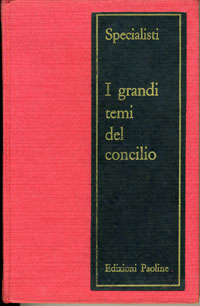Fr. Hans Kung has the merit of speaking frankly about the goals of Progressivism. In doing so, he becomes a useful source for us to know straightforwardly the intentions of this current.
Nothing could be more important than knowing its intention regarding Vatican II. What was the main reason for its convocation? Kung answers the question. Read his explanation below.
The article by Kung is a collaboration for a work coordinated by Fr. Alting von Geusau, director of the Dutch Documentary Center, published soon after Vatican II.
At right is the cover of the book I grandi temi del Concilio [The Great Themes of the Council]. At right below, photocopies of the Italian text. Below, we present our translation of the lines highlighted in yellow.
The Council was convened by the Holy Father to prepare for reconciliation. When he first announced it, he expressed this with extraordinary clarity, which is the reason why Vatican II .... was received with joy and hope everywhere. The Holy Father did not swerve from that purpose, and the observers of the great non-Catholic confessions present at all the sessions .... with their presence continuously reminded the conciliar fathers to not lose sight of the final aim of the Council: reconciliation with the separated Christians.
Then, the question arises: How can this reconciliation become a reality? It is not, as many Christians imagine - especially the Evangelicals, primarily by means of organized discussions and inter-confessional conferences of the leaders .... It is also not, as many Christians would desire - especially the Catholics, by tranquilly inviting the others to come to their own Church - as if the others had something for which they needed to be forgiven - or through the conversion of individuals .... or simply by a general reform of customs ....
Vatican II saw its mission in a very different way: reconciliation with the separated Christians can only be accomplished by means of a renewal of the Catholic Church herself.
The renewal of the Catholic Church leading toward reconciliation: this great goal can be reached by methodically realizing the legitimate desires of the others - Orthodox, Evangelicals, Anglicans and independent churches - under the light of the Gospel of Jesus Christ, which judges what is legitimate in those desires and what is not.
(Hans Kung, "La Riforma Liturgica del Concilio Vaticano II e la Riunione con I Cristiani Separati, in I Grandi Temi del Concilio, Rome: Paoline, 1965, pp. 103-105).
|



 |
